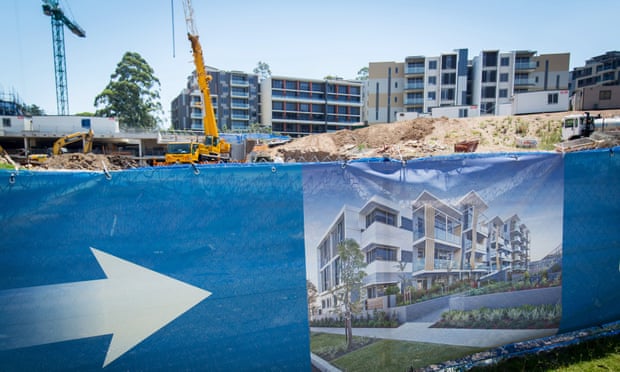These are exactly the same banks that we have in New Zealand, yet nobody is writing about this here. The NZ media is complete cloud cuckoo land.
Banks have treated our housing market like a Ponzi scheme, and it's about to bus
Australia’s housing market is looking a lot like the US, Ireland and Spain before the global financial crisis. Why aren’t politicians more concerned?

The Guardian,
20 August, 2015
Australia’s big four banks are among the largest and most profitable financial institutions in the world. Despite this, it is mathematically impossible that these banks, primarily focused on domestic retail operations, could be as big and profitable as they currently are without one of the following taking place:
- either each of these banks, in their individual capacity, has solved (at the same time, in the same country, and as a first in the history of banking) the ultimate recipe for infinitely profiting from an exponentially-growing stock of private debt; or
- they are all engaged in activity which is incredibly risky.
Looking
at the balance sheets of these four banking leviathans they have
clearly taken on abnormal sums of risk to invest in a single, all-in,
one-way bet on the housing market.
As
my colleague Philip Soos and I told the House of Representatives’
economics committee inquiry into home ownership last week, the
evidence suggests that on the back of irrational exuberance,
Australia is experiencing what can only be described as a classic
debt-financed speculative housing bubble with every metric that
evidenced the bubble in the US and Ireland present within our
economic system today.
Between
2002 and 2015, the mortgage books of National Australia Bank, ANZ,
Commonwealth Bank and Westpac grew by 388%, 435%, 475% and 554%
respectively. Put another way, the big four’s mortgage books
escalated from a combined $242bn to a whopping $1.13tn, surging at
such a consistent rate it would make Bernie Madoff proud.
What
the Australian banking system has developed is an uninterrupted
growth model which shares a similar risk profile as a Ponzi or
pyramid scheme by lending ever-larger sums of debt to homebuyers and
property investors year after year. If this growth model is
interrupted, however, and banks cannot expand their mortgage books
further, housing price inflation halts and will then plunge.
Lending
an exponentially increasing stock of credit to the public creates a
distorted asset market by artificially driving up demand needlessly.
In Australia’s case, the target for this debt splurge is the
housing market, easily one of the most overvalued and unaffordable in
the western world.
The
next time you’re watching an auction in Sydney or Melbourne,
wondering where all these buyers managed to muster up so much cash,
chances are they have a domestic retail bank prepared to lend them a
colossal sum of debt using new equity in their existing property
portfolio as collateral that didn’t exist just 12 months ago.
Despite some
notable exceptions, Australia’s mainstream economists and
policymakers have either failed to identify, or have chosen to ignore
the unmistakable link between the rapid rise in house prices and the
eye-watering sum of mortgage debt Australian households have
now accumulated.
On
the rare occasion when one challenges the perceived fundamentals
of the Australian housing and mortgage markets, the view is often
brushed aside and considered a “lazy analysis” versus the
mainstream view that high house prices in Australia are a rational
outcome of efficient markets, superior risk management and falling
nominal interest rates.
That’s
precisely what the Americans, Irish and Spaniards were thinking
before hell froze over their property markets and banking systems.
Government,
Treasury, the central bank (RBA) and the prudential regulator (Apra)
do not seem overly concerned about booming mortgage debt. By cutting
the cash rate to the lowest point in a long time, the RBA has simply
furthered the Ponzi scheme running rampant in Sydney and Melbourne,
which dominates Australia’s housing market in terms of size and
value.
If
either of these two major housing markets hits a brick wall, it will
burst the national housing bubble. Policymakers and the public,
unfortunately, will come to realise there never was a dwelling
shortage – rather, a radical oversupply of mortgage debt being the
real culprit for abnormally-high housing prices.
Australia’s
economists have not learnt the lessons made obvious by the global
housing bubble, especially in the US. While claiming dwelling
shortages justified sky-high prices, none except a small number of
American economists were competent enough to realise that more than
enough dwellings were constructed to house the flow of new households
formed over the course of the price boom, and any such shortage
would’ve been evidenced by a strong surge in rents (steady yields).
At
Apra, their recent and impotent response has been to implement weak
macroprudential regulations. Formed in 1998, they have remained
complacent, observing from the sidelines while Australia has built up
a mountain of unconsolidated household debt, currently at 119.3% of
GDP. And as of early 2015, ranking third place behind Switzerland and
Denmark.
The
housing market is sure to follow the path of the mining industry.
Policymakers believed the mining boom would last for decades,
boosting the economy. With the mining sector now collapsing, the
public will inevitably realise rising housing prices cannot last
forever. The imposition of grossly inefficient neoliberal financial
economics has plagued many nations recently with asset bubbles –
Australia is no different.



No comments:
Post a Comment
Note: only a member of this blog may post a comment.